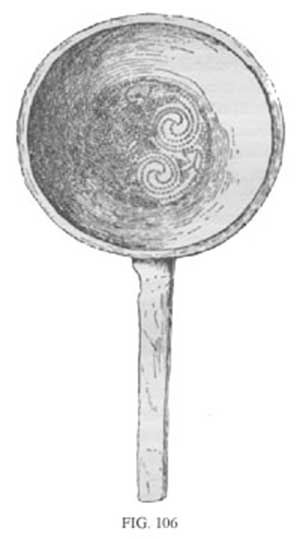Drink
From A Smaller Social History of Ancient Ireland 1906
« previous page | contents | start of chapter | next page »
CHAPTER XVII....continued
2. Drink.
In old times people were quite as fond of intoxicating drinks at dinners and banquets as they are now: and we are constantly told in the tales that when the cups went round, the company became exhilarated and right merry. They sometimes drank more than was good for them too: yet drunkenness was looked upon as reprehensible. At their feasts they often accompanied their carousing with music and singing. Maildune and his men, visiting a certain island, saw the people feasting and drinking, and "heard their ale-music."
Besides plain water and milk, the chief drinks were ale, mead or metheglin, and wine. Giraldus Cambrensis remarks that Ireland never had vineyards: but that there was plenty of wine supplied by foreign commerce; and he mentions Poitou in France especially as supplying vast quantities in exchange for hides. This account is corroborated by the native records, from which we learn that wine was imported in very early ages, and it is frequently mentioned as an accompaniment at banquets.
Of all the intoxicating drinks ale was the most general, not only in Ireland, but among all the peoples of northern Europe: and the more intoxicating it was the more esteemed. Irish ale was well known from the earliest period, even on the Continent, as we see from the statement of Dioscorides in the first century: —"The Britons and the Hiberi or Irish, instead of wine, use a liquor called courmi or curmi, made of barley." This author caught up correctly the ancient Irish name for ale, which was cuirm or coirm.
FIG. 106. Bronze Strainer found in a crannoge. Cup-shaped, 4½ inches wide and 1½ inch deep. Observe the holes form curve-patterns. (From the Journ. Roy. Soc. Antiqq. Irel.).
The present word for ale is linn or leann: and although this, too, was one of the words for ale in old times, it was often used to denote drink in general. The manufacture of ale was understood everywhere; and the whole process is given in detail in the Senchus Mór, and in the commentaries and glosses on it. The grain chiefly used was barley; and what grew on rich land was most valued for the purpose: but it was also often made from rye, as well as from wheat and oats. The corn, of whatever kind, was first converted into malt: Irish brac or braich; by steeping in water and afterwards drying. The dried malt kept for any length of time, and was often given in payment of rent or tribute.
When the ale was to be prepared, the ground malt was made into mash with water, which was fermented, boiled, strained, &c., till the process was finished. Ale was often made in private houses for family use: for everywhere among the people there were amateur experts who understood the process. But there were houses also set apart for this purpose, where a professional brewer carried on the business. When people felt indisposed or out of sorts, it was usual to give them a draught of ale to refresh or revive them, as we now give a cup of tea or a glass of wine.
Mead or metheglin (Irish mid, pron. mee) was made chiefly from honey: it was a drink in much request, and was considered a delicacy, so that a visitor on arrival was often treated to a cup of mead. It was slightly intoxicating. Mead continued to be made in many parts of Ireland till very recently.
Whiskey is a comparatively modern innovation. The first notice of it in the Irish annals appears to be at A.D. 1405, where there is the ominous record that Richard Mac Rannal, chief of Muinter Eolais, died from an overdose of uisge beatha [iske-baha] or whiskey.

